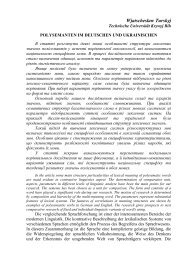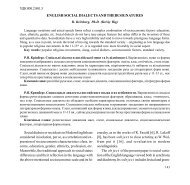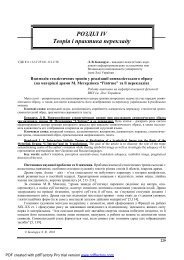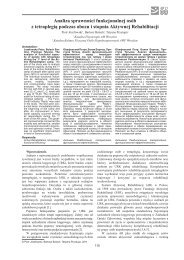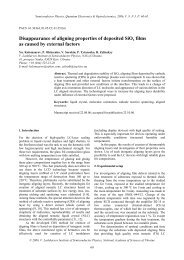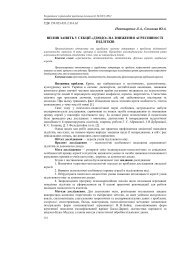UDC 621.3 REAL-TIME REGULATION SYSTEMS BASED ON ...
UDC 621.3 REAL-TIME REGULATION SYSTEMS BASED ON ...
UDC 621.3 REAL-TIME REGULATION SYSTEMS BASED ON ...
Create successful ePaper yourself
Turn your PDF publications into a flip-book with our unique Google optimized e-Paper software.
<strong>UDC</strong> <strong>621.3</strong><br />
ІНФОРМАЦІЙНІ СИСТЕМИ І МОДЕЛЮВАННЯ<br />
<strong>REAL</strong>-<strong>TIME</strong> <strong>REGULATI<strong>ON</strong></strong> <strong>SYSTEMS</strong> <strong>BASED</strong> <strong>ON</strong> INTERNET – OPTIMIZATI<strong>ON</strong><br />
ALGORITHM<br />
Vince T., research, Ing., assist. Prof., Molnár J., research, Ing., assist. Prof., Bučko R., research, Ing., assist. Prof.<br />
Technical University of Košice<br />
Park Komenského 3, 04200 Košice, Slovak Republic<br />
E-mail: tibor.vince@tuke.sk , jan.molnar@tuke.sk , radoslav.bucko@tuke.sk<br />
The article presents one of the ways for implementing Internet as a communication bus between real-time system<br />
elements. It handles the advantages and disadvantages of Internet as a control and communication bus in different level<br />
of the information hierarchy. The paper describes algorithm, which helps to build network for a real-time system. This<br />
algorithm is suitable for creating new network, or own domain of system elements. For implementing system in existing<br />
network, there would be few modifications in algorithm.<br />
Key words: Internet, real-time system, algorithm.<br />
Introduction. The Internet begins to playing a very<br />
important role in industrial processes manipulation, not<br />
only in information retrieving. New concept of<br />
controlling, which has been paid much attention in these<br />
years is distance remote via Internet, or other words,<br />
Internet-based control. Such a type of control bus allows<br />
remote monitoring or regulation of plants or single<br />
devices over the Internet. With the progress of the<br />
Internet it is possible to control and regulate from<br />
anywhere around the world at any time. The design<br />
process for the Internet-based control systems includes<br />
requirement specification, architecture design, control<br />
algorithm, interface design and possibly safety analysis.<br />
Due to the low price and robustness resulting from its<br />
wide acceptance and deployment, Ethernet has become<br />
an attractive candidate for real-time control networks.<br />
Requirements to put Internet depend on the system.<br />
Since each system has its own requirements, there is no<br />
prototype of such Internet bus. Therefore there should<br />
exist an algorithm for building suitable network.<br />
Specific algorithm depends on the number of system<br />
elements (if system is complex or not), if system should<br />
be implemented in existing network, or it is necessary<br />
build a new one etc. This contribution solves the cases,<br />
when system needs to build a new network, or all<br />
system elements could be included in system own<br />
network domain.<br />
Network Performance. Network performance is<br />
referred in more parameters in mutual relationship. One<br />
of performance parameters is Latency. Latency means a<br />
time required to transfer an empty message between<br />
relevant computers. Another parameter is Data transfer<br />
rate. Data transfer rate is the speed at which data can be<br />
transferred between sender and receiver in a network.<br />
The unit of this parameter is Bits/sec. For message<br />
transfer time calculating is equation 1. A third parameter<br />
of network performance is Bandwidth. Bandwidth is a<br />
total volume of traffic that can be transferred across the<br />
network. Maximal data rate formula is shown in<br />
equation 2. This maximum is only theoretical, not<br />
reachable in practice [5].<br />
LM<br />
MTT = LT + (1)<br />
DTR<br />
where MTT is Message transfer time, LT is latency, LM<br />
is Length of message and DTR is Data transfer time.<br />
sg<br />
MDR = CB . log 2 (1 + )<br />
ns<br />
(2)<br />
where MDR is maximal data rate (bps) and CB is carrier<br />
Bandwidth, sg is signal magnitude and ns is noise<br />
magnitude.<br />
The all parameters are pointing on the main<br />
disadvantage of controlling via the Internet – packets<br />
delivery delay. When packets are concurrently<br />
transported over an ordinary Ethernet, packets may<br />
experience a large delay due to contention with other<br />
packets in the local node where they originate and<br />
collision with other packets from the other nodes. By<br />
data transmission, four sources of delay spring up at<br />
each hop: nodal processing, queuing, transmission delay<br />
and propagation delay. The most significant part of total<br />
delay belongs to queuing. By queuing is considered the<br />
following equation 3:<br />
A<br />
TI = L . (3)<br />
W<br />
where TI is traffic intensity, L is packet length (bits), A<br />
is average packet arrival rate, and W is link bandwidth<br />
(bps).<br />
If ratio L*A/W will be very small almost 0, average<br />
queuing delay is small. If ratio L*A/W rise up to 1,<br />
delays become large (exponentially) and if ratio L*A/W<br />
is bigger than 1 average delay is infinite, more “work”<br />
arriving than can be serviced. Today, there is a term<br />
Quality of Service (QoS). Quality of Service is the<br />
ability to provide different priority to different<br />
applications, users, or data flows, or to guarantee a<br />
certain level of performance to a data flow.<br />
Information Architecture. It is becoming<br />
increasingly necessary to think in terms of integration of<br />
information and control, across the entire plant site. The<br />
term of integration, especially integration of information<br />
and control across the entire plant site, becomes more<br />
and more significant. In the manufacturing industries<br />
this is often referred to as "Computer Integrated<br />
Manufacturing" (CIM). On the surface, it would seem<br />
that the increasing use of microprocessor-based plant<br />
level devices such as programmable controllers,<br />
distributed digital control systems, smart analyzers,<br />
personal computers, etc., would make this easy. After<br />
all, most of these devices have "RS232" connectors,<br />
which enable connection to computers. Unfortunately,<br />
the real world situation is somewhat more challenging.<br />
Вісник КДУ імені Михайла Остроградського. Випуск 4/2010 (63). Частина 3<br />
150
If we began to hook all these RS232 ports together,<br />
there would soon be an unmanageable mess of wiring,<br />
custom software and little or no communication. This<br />
problem solution results in integration these devices into<br />
a meaningful "Information Architecture". This<br />
Information Architecture can be separated into 4 levels<br />
with the sensor/actuator level as shown in Fig. 1, which<br />
are distinguished from each other by“4Rs” principle<br />
criteria.<br />
Local<br />
Computer<br />
fast<br />
more<br />
slow<br />
less<br />
Response time Resolution Reliability Reparability<br />
ІНФОРМАЦІЙНІ СИСТЕМИ І МОДЕЛЮВАННЯ<br />
Scheduling,<br />
Management<br />
easy<br />
low<br />
Optimisation,<br />
Maintenance<br />
Supervisory<br />
Control<br />
high<br />
Interlocking<br />
& Regulatory<br />
hard<br />
Figure 1- Information Architecture<br />
Sensor,<br />
Actuator<br />
The 4Rs criteria are: Response time, Resolution,<br />
Reliability and Reparability.<br />
Response time: as one moves higher in the<br />
information architecture, the time delay, which can be<br />
tolerated in receiving the data, increases. Conversely,<br />
information used at the management & scheduling level<br />
can be several days old without impacting its usefulness.<br />
Resolution: an Abstraction level for data varies<br />
among all the levels in the architecture. The higher the<br />
level is, the more abstract the data is.<br />
Reliability: Just as communication response time<br />
must decrease as one descends through the levels of the<br />
information architecture, the required level of reliability<br />
increases. For instance, host computers at the<br />
management & scheduling level can safely be shut<br />
down for hours or even days, with relatively minor<br />
consequences. If the network, which connects<br />
controllers at the supervisory control level and/or the<br />
regulatory control level, fails for a few minutes, a plant<br />
shutdown may be necessary.<br />
Reparability: The reparability considers the ease<br />
with which control and computing devices can be<br />
maintained.<br />
Local computer on supervisory control level is able<br />
communicate with higher levels of information<br />
architecture via Internet, but there is also possibility to<br />
use the Internet also in lower levels of the Information<br />
architecture. The Internet can be linked with the local<br />
computer system at any level in the information<br />
architecture, or even at the sensor/actuator level. These<br />
links result in a range of 4Rs (response time, resolution,<br />
reliability, and reparability). For example, if a fast<br />
response time is required a link to the control loop level<br />
should be made. If only abstracted information is needed<br />
the Internet should be linked with a higher level in the<br />
information architecture such as the management level<br />
or the optimization level.<br />
Industry’s Buses. There are various types of buses<br />
using in Industry to connect of different devices, which<br />
are supported on the type of interface/bus [6]:<br />
AS-Interface – the Actuator Sensor Interface offers<br />
many of the benefits of more powerful and expensive<br />
fieldbuses, but at much lower cost and as a much<br />
simpler installation. Transmission of analog signals via<br />
time multiplex procedure. Data and power via the same<br />
line. No termination necessary. Address setting<br />
automatically from the master or via service tool. ASI<br />
conforment power supply required. It supports 62 nodes,<br />
max 300m with 3 repeaters. Date rate is 167kbit/s.<br />
Addressing is Master/Slave.<br />
CANopen – is a CAN-based higher layer protocol. It<br />
was developed as a standardized embedded network<br />
with highly flexible configuration capabilities. Node<br />
removal without severing the network is possible.<br />
Provisions for the typical request/response orientated<br />
network communications. Provisions for the effiecient<br />
movement of data framentation for moving larger bodies<br />
of information It supports 127 nodes, 25-5000m<br />
(depending on boudrate). Data rate is from 10kbit/s to<br />
1Mbit/s, addressing is Master/Slave, Peer-to-Peer,<br />
Multi-cast and Multi-master.<br />
ProfiBus – is a Multi-Master System and makes<br />
possible the mutual operation of several automation,<br />
engineering or visualizing systems at a Bus. The<br />
Masters, also designated as active devices, define the<br />
data traffic on the Bus. When in possession of the access<br />
permission (Token), they can send data without external<br />
requests. The Slaves, designated as passive devices,<br />
have no Bus access permission. They can only confirm<br />
received messages or send messages when requested by<br />
a Master. Baud rates from 9.6 kBaud up to 12 MBaud<br />
are supported. A maximum of 126 devices can be<br />
operated at the Bus. Profibus also supports Broadcast<br />
and Multicast communication. Network length is<br />
possible 100-1200m, addressing is DP: Master/Slave,<br />
Cyclic, Polling, DPV1: Cyclic, Polling + acyclic data<br />
transfer.<br />
EthernNet/IP – The Industrial Ethernet Protocol<br />
(Ethernet/IP) has been developed by ODVA with strong<br />
support from Rockwell Automation. It uses the Control<br />
& Information Protocol (CIP) which is already well<br />
known from ControlNet and DeviceNet. Network size<br />
(number of nodes) is scalable and nearly unlimited.<br />
Network size can be 100m (10/100 Base-T) or 35-<br />
2000m (fiber optic). Standard layers 1-4 providing<br />
Ethernet data transmisson, bus access, internet protocol<br />
(IP) and TCP & UDP protocols. CIP "implicit" and<br />
"explicit" messaging with encapsuslation technology.<br />
Message routing between EtherNet/IP, DeviceNet &<br />
ControlNet.<br />
Network Improve Methods. If the network doesn’t<br />
meet system requirements, it should be improved.<br />
Among the ordinary methods of improvement we can<br />
include: improvement of network architecture,<br />
improvement of network bandwidth and special<br />
protocols implementation. The sequence of these<br />
methods in algorithm can vary depending for example<br />
on the cost of implementing these methods.<br />
Improvement of network architecture can lead to the<br />
increase of the number of nodes, branches and changing<br />
architecture. The goal is to decrease network traffic jam<br />
and that way decrease packets time delay in.<br />
Вісник КДУ імені Михайла Остроградського. Випуск 4/2010 (63). Частина 3<br />
151
Classic Ethernet has 10MBps bandwidth and has<br />
reserve in 100MBps and also 1GBps bandwidth.<br />
Widening Ethernet bandwidth is another way to<br />
decrease packet delivery time. It is possible to decrease<br />
time delay by using special protocols, for example<br />
RSVP- Resource Reservation Protocol, IPv6-support<br />
packet priority.<br />
Applied special protocols must be supported by all<br />
network elements. Special protocols are meaningful<br />
only in complex systems.<br />
Time deterministic Ethernet is a special way for<br />
decreasing time delay. For example: Industrial Ethernet,<br />
Ethernet Powerlink etc. Deterministic timing is achieved<br />
by applying a cyclic timing schedule for all connected<br />
nodes to access the physical layer. To apply<br />
deterministic type of Ethernet, all system elements in a<br />
real-time domain must support such type of Ethernet.<br />
The last chance to use Internet is to modify system<br />
requirements. Sometimes, with small system changes,<br />
can modified system requirements meets the network<br />
parameters.<br />
Algorithm.<br />
The whole diagram is shown in figure Fig. 2<br />
The first step is dataflow analysis. The most<br />
important question that needs to be answered is the<br />
following: What amount of data will be transported over<br />
the net and what is the greatest acceptable time delay?<br />
The next step is an architecture proposal. The<br />
architecture should follow dataflow analysis. The first<br />
architecture proposal should be as simple as possible.<br />
Next there is network type proposal. Network type<br />
determines network bandwidth, type of wiring etc. The<br />
first proposal of network should be with low bandwidth.<br />
After first proposals, there is a testing, if the network (as<br />
simple as possible) meets the system requirements. This<br />
is the most difficult part of the algorithm – to answer<br />
this question.<br />
The answer should include the most inopportune<br />
system state with the biggest possible network traffic<br />
jam. To answer the question for simple systems it is<br />
possible to use calculation, but it is better to use some<br />
simulation tools (OMNeT++, ns2, OPNET …) for more<br />
complex systems.<br />
In case of special (not standard) situations the time<br />
delay exceeds the system requirements, the system<br />
needs to be maintained to handle such situations.<br />
Algorithm is shown in figure Fig. 3. It is possible to<br />
ignore such situations when they appear rarely and time<br />
delay exceeding does not cause system to malfunction.<br />
Conclusion. It is become to be a standard, that<br />
many control elements have been embedded with<br />
Internet-enabled functions, for example, PLC with<br />
TCP/IP stack, smart control valves with a built-in<br />
wireless communication based on TCP/IP protocol, and<br />
process control computer (DCS) with an Internet<br />
gateway. There possibility that some mechatronic<br />
system could be connected directly to the Internet<br />
(without a necessity of a server computer).<br />
These days, there is effort to utilize Internet also in<br />
real-time systems. However there is no guide for<br />
building such a network yet. This algorithm describes<br />
ІНФОРМАЦІЙНІ СИСТЕМИ І МОДЕЛЮВАННЯ<br />
one of the possible ways. The whole algorithm aims to<br />
build a network that is as simple as possible and<br />
gradually improve it until the network parameters meet<br />
the system requirements.<br />
Requirements of feedback less than tens of<br />
miliseconds can be achieved only with deterministic<br />
type of Ethernet, but all devices in real-time domain<br />
must support such type of Ethernet. Time delay<br />
exceeding can be ignored, when it does not cause<br />
system malfunction.<br />
Is is possible to apply<br />
special protocols to<br />
speed up the<br />
communication ?<br />
are the<br />
system<br />
requirements<br />
satisfied ?<br />
Вісник КДУ імені Михайла Остроградського. Випуск 4/2010 (63). Частина 3<br />
152<br />
yes<br />
apply suggest<br />
network<br />
no<br />
no<br />
no<br />
Is it possible to<br />
apply time<br />
deterministic type<br />
of Ethernet ?<br />
no<br />
Is it possible to<br />
change system<br />
requirements ?<br />
no<br />
new network<br />
creation<br />
algorithm<br />
data flow<br />
analysis<br />
architecture<br />
proposal<br />
network type<br />
proposal<br />
Is is possible to<br />
apply higher<br />
bandwidth net ?<br />
no<br />
Is it possible to<br />
change the net<br />
architecture to<br />
decrease network<br />
delay ?<br />
yes<br />
apply the special<br />
protocols<br />
change the system<br />
requirements<br />
yes<br />
apply the higher<br />
bandwidth net<br />
apply time deterministic<br />
type of Ethernet<br />
yes<br />
change the<br />
architecture<br />
yes<br />
maintain<br />
are the<br />
requirements<br />
satisfied in<br />
standard state of<br />
system and net ?<br />
no<br />
in these circumstances is<br />
not possible to build system<br />
bus based on the Ethernet<br />
yes<br />
yes<br />
Figure - 2 The algorithm<br />
Acknowledgement. The paper has been prepared by<br />
the support of Slovak grant projects VEGA 1/0660/08,<br />
KEGA 3/6386/08, KEGA 3/6388/08, KEGA 003-<br />
003TUKE-4/2010
yes<br />
maintain the system for<br />
time-delay exceeding<br />
apply suggest<br />
network<br />
no<br />
maintain<br />
Is it possible to<br />
maintain the system in<br />
handling with<br />
situations, when time<br />
delay exceeds the<br />
system requirements ?<br />
Exceeding a<br />
time delay<br />
limit would<br />
cause system<br />
malfunction ?<br />
Figure - 3 The system maintain algorithm<br />
ІНФОРМАЦІЙНІ СИСТЕМИ І МОДЕЛЮВАННЯ<br />
no<br />
yes<br />
in these circumstances is<br />
not possible to build<br />
system bus based on<br />
the Ethernet<br />
REFERENCES<br />
1. Yang, S.H., Tan, L.S., Chen X: Requirements<br />
Specification and Architecture Design for Internet-based<br />
Control Systems, proceedings of the 26th Annual<br />
International Computer Software and Applications<br />
Conference (COMPSAC’02), 2002.<br />
2. Kweon, S. K, Cho M., Shin K. G.: Soft Real-<br />
Time Communication over Ethernet with Adaptive<br />
Traffic Smoothing, IEEE Transactions on parallel and<br />
distributed systems, VOL. 15, NO. 10, October 2004.<br />
3. Hall E.: Internet Core Protocols: The Definitive<br />
Guide, O'Reilly & Associates (February, 2000) USA,<br />
ISBN: 1-56592-572-6.<br />
4. Yang, X., Chen Q.: Virtual Reality Tools for<br />
Internet-Based Robotic Teleoperation, proceedings of<br />
the 8th IEEE International Symposium on Distributed<br />
Simulation and Real-Time Applications (DS-RT’04).<br />
5. Fonda C., Postogna F.: Computer networking<br />
basics, ICTP workshop on telecommunications: science,<br />
technology and applications. Trieste, 15th September -<br />
3rd October 1997<br />
6. http://www.anybus.com/technologies/technolog<br />
ies.shtml, 10.2.2008<br />
7. Molnár, J., Kováčová, I.: Distance remote<br />
measurement of magnetic field. In: Acta Electrotechnica<br />
et Informatica, 2007, Vol.7, No.4, pp. 52-55, ISSN<br />
1335-8243.<br />
8. Molnár, J.: Telemetric system based on<br />
internet. In: OWD 2009 : 11 International PhD<br />
Workshop : Wisa, 17-20 October 2009, p. 38-41. ISBN<br />
83-922242-5-6.<br />
9. Kováčová, I., Kováč, D.: Non-harmonic power<br />
measuring. In: Acta Electrotechnica et Informatica. Vol.<br />
8, No. 3 (2008), pp. 3-6. ISSN 1335-8243.<br />
10. Tomčík, J., Tomčíková, I.: Safety politics in the<br />
enviroment of the automatized and SCADA systems ( In<br />
Slovak). In: EE Journal. Vol. 14, No. 1 (2008), pp. 46-<br />
47. ISSN 1335-2547<br />
11. Vince, T., Molnár, J., Tomčíková, I.: Remote<br />
DC motor speed regulation via Internet. In: OWD 2008:<br />
10th international PhD workshop : Wisla, 18-21 October<br />
2008. p. 293-296. ISBN 83-922242-4-8.<br />
Вісник КДУ імені Михайла Остроградського. Випуск 4/2010 (63). Частина 3<br />
153<br />
Стаття надійшла 20.04.10 р.<br />
Рекомендовано до друку к.т.н., доц.<br />
Гладирем А.І.<br />
СИСТЕМЫ РЕАЛЬНОГО ВРЕМЕНИ НА ОСНОВЕ АЛГОРИТМА ИНТЕРНЕТ-<br />
ОПТИМИЗАЦИИ<br />
Винс Т., научный сотрудник, инж., ассист., Мольнар Дж., научный сотрудник, инж., ассист., Бучко Р.,<br />
научный сотрудник, инж., ассист.<br />
Технический университет в Кошице<br />
Park Komenského 3, 04200, Košice, Slovak Republic<br />
E-mail: tibor.vince @ tuke.sk, jan.molnar @ tuke.sk, radoslav.bucko @ tuke.sk<br />
Данная статья представляет один из способов применения Интернета в качестве коммуникационной шины<br />
между элементами системы реального времени. Рассмотрены преимущества и недостатки Интернета как шины<br />
управления и коммуникационной шины на различных уровнях информационной иерархии. В статье<br />
описывается алгоритм, который облегчает создание сети для систем реального времени и пригоден для<br />
создания, как новой сети, так и собственного домена элементов системы. При внедрении системы в<br />
существующую сеть потребуются некоторые изменения в алгоритме.<br />
Ключевые слова: Интернет, система реального времени, алгоритм<br />
СИСТЕМИ РЕАЛЬНОГО ЧАСУ НА ОСНОВІ АЛГОРИТМУ ІНТЕРНЕТ-<br />
ОПТИМІЗАЦІЇ<br />
Вінс Т., науковий співробітник, інж., асист., Мольнар Дж., науковий співробітник, інж., асист., Бучко Р.,<br />
науковий співробітник, інж., асист.<br />
Технічний університет в Кошице<br />
Park Komenského 3, 04200, Košice, Slovak Republic<br />
E-mail: tibor.vince @ tuke.sk, jan.molnar @ tuke.sk, radoslav.bucko @ tuke.sk<br />
Дана стаття представляє один зі способів застосування Інтернету в якості комунікаційної шини між<br />
елементами системи реального часу. Розглянуто переваги і недоліки Інтернету як шини управління та<br />
комунікаційної шини на різних рівнях інформаційної ієрархії. У статті описується алгоритм, який полегшує<br />
створення мережі для систем реального часу і придатний для створення, як нової мережі, так і власного домену<br />
елементів системи. При впровадженні системи в існуючу мережу будуть потрібні деякі зміни в алгоритмі.<br />
Ключові слова: Інтернет, система реального часу, алгоритм.



